What aluminum heating radiators are better: strengths and
A person who has not previously faced the question of selecting a radiator can easily fall into a stupor if necessary choose a heating device. Even within the framework of one type of radiators, there are more than one dozen different models, differing not only in size, but also in design. So it makes sense to sort out this issue in more detail.

Strengths and weaknesses of aluminum batteries
Before turning to the question of which aluminum radiators are better, it is worth understanding their advantages and disadvantages.
The advantages can be written:
- high thermal conductivity, thanks to this, the heating device heats up very quickly, although this is not very important from the point of view of heating efficiency;
- great appearance. Typical radiators of this type are produced in white, but you can also find colored models if you wish, however, they will cost more;
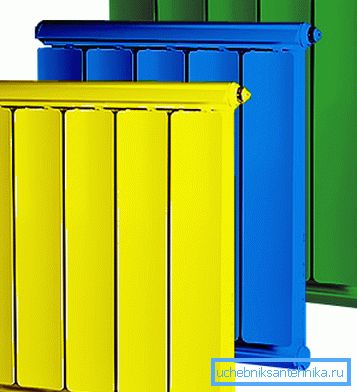
- the thermal power of one section of the best representatives of this class can reach 200 W. Such an outstanding result is achieved due to the developed surface of the fins;
- the shape of the battery fins is designed so that the heat transfer to the room goes in 2 ways - due to convection and by conventional thermal radiation from the metal surface. Due to this, the heating of the room goes more evenly;
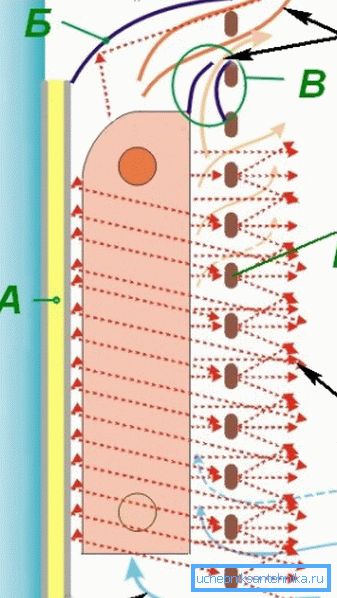
- the weight of the whole radiator is small, This is important if the installation is done by hand without helpers;
- the volume of water in the heating device is less than, for example, in the cast-iron analog, in one section there is only up to 0.45 l of water. This quality is useful in autonomous heating systems when a relatively low-power circulating pump is installed.
It also didn’t do without drawbacks, but it’s difficult to call them critical:
- Aluminum alloy is very sensitive to the quality of the coolant (we are talking about the level of -pH), it is undesirable that this indicator was above 7-8. According to this criterion in the question that steel or aluminum radiators are better, preference should be given to steel;
Note! There is no possibility to regulate the quality of coolant in urban apartments, so there is a risk of premature radiator failure.
- the presence of solid inclusions in water is also undesirable. They easily damage the protective layer on the inner surface of the radiator, and this increases the risk of aluminum corrosion;
- the price of such heaters is higher than that of ordinary cast iron, but lower than the cost of copper or bimetallic models;
- over time, the battery is airing, but this is not critical, the excess air can always be released through the Mayevsky valve;
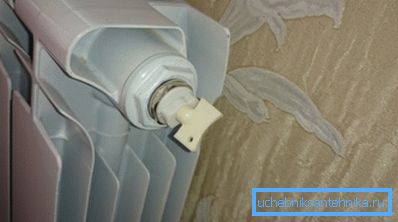
- in some models, the diameters of the vertical channels of the collector are so small that they can easily clog if there are solid inclusions in the coolant.
With such a balance of advantages and disadvantages, it becomes clear why aluminum radiators are so popular.
Comparison of aluminum radiators with competitors
Aluminum alloy is not the only material from which heating devices can be made. Iron and steel analogues can be found on sale; if the budget allows it, then bimetal can be purchased.
A brief comparison of heating radiators
It is convenient to compare different types of batteries for the main operational characteristics:
- the permissible coolant temperature - cast iron batteries for this indicator took the lead (water temperature can reach 150? C). If we compare which radiator is better than aluminum or steel, then according to this indicator steel batteries are the losers, for them the maximum coolant temperature is only 110-120? С;
- over working pressure, the spread of values is very large, cast iron does not work well in tension, therefore the pressure for it should not exceed 6-9 bar, for steel - 10-12, aluminum alloy - 6-25, and for bimetal - 16-36. Much of this depends on the manufacturer;
- in terms of heat output, aluminum and bimetallic batteries are again among the leaders, this indicator can reach 200 watts. In steel, the power of one section is approximately 150 W, and in iron, it can reach 160 W;
- it is necessary to take into account the weight of the section, this is especially important when self-installing radiators on the wall. Bimetal and aluminum weigh a little, the weight of one section depending on the center distance can be 1-2 kg, for comparison, the weight of the cast iron section will be from 7 kg, and the weight of the entire radiator can exceed 100 kg;

- the only parameter by which aluminum loses to the other materials is the type of coolant, only water is suitable for this metal, whereas any liquid can be used for other materials. But in most cases, it is water that is chosen for the role of coolant, so if you need to choose aluminum or steel radiators, then steel is the loser.
Solid or cast radiator to choose
In terms of strength, the molded version is much better. The fact is that there are no joints between the individual sections, so that the risk of leakage in this place is minimal. So if in the heating system there are frequent hydraulic shocks or just the pressure can sometimes exceed the maximum working one, then it is better to choose such an option.
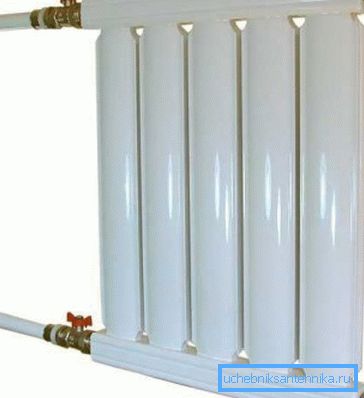
Note! It is impossible to regulate the heat transfer of monolithic radiators by adding separate sections, as can be done with sectional ones. But this problem can always be solved by installing a thermostat.
In addition, the cast model is a little more material due to the greater thickness of the walls and edges. Of the features, it is possible to distinguish the composition of the metal, because aluminum alloy with silicon is used, so the material is quite brittle. But this does not mean that the best aluminum radiators are exclusively sectional, it’s just that each of these options is good in certain conditions.
As for the sectional models, their only drawback is that the joints with water hammer can start to flow. They also warm up a little faster than the cast ones, because the walls of the heater are thinner, and the coolant also fits into the battery more.
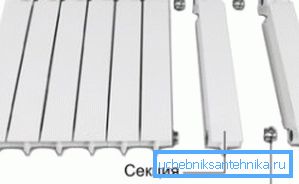
When choosing, attention should be paid to the material from which the heater is made. The fact is that lately, secondary aluminum has been used for manufacturing (metal, obtained during the processing of various wastes). Products made from it are somewhat inferior in strength to primary aluminum batteries.
In general, if in the first place when choosing is the strength of the metal, then in the question, it is better to choose an aluminum or steel radiator to give preference to the steel variant. Still, steel material is much more durable than aluminum.
Product overview of popular manufacturers
If we evaluate the manufacturers of the whole world, then the leading positions are occupied by such manufacturers as Ferroli, Global, Sira, Faral came close to them.
The products of these manufacturers have a very durable coating that does not crack even at extreme temperatures, and on the inside, aluminum is protected by a special polymer film that does not affect the heat transfer. From here and high durability, and also weight of positive responses.
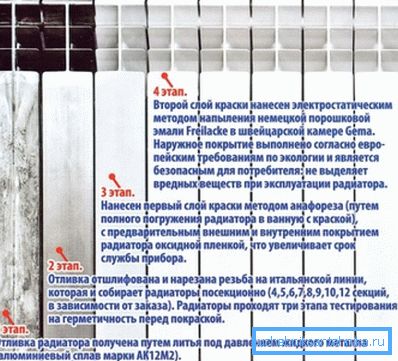
Note! If the installation is planned in a city apartment, then when choosing it is worth paying attention to the diameter of the vertical channels, with some models it may be about 6 mm, such a hole can clog very quickly.
The rating of aluminum radiators for heating also includes Russian batteries from Rifar (technically, its products are a complete copy of Italian competitors, but production is carried out under license, so the company has no problems with the law).
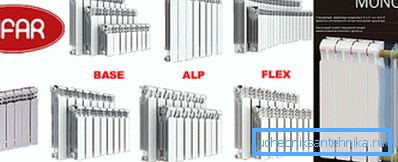
The ubiquitous Chinese companies are in demand, you can pick out Bilux, Konner, they look better against the rest. At the same time, the stereotype that China is synonymous with poor quality does not work anymore. The fact is that the same Italian companies sell their licenses around the world without any problems, so the Chinese battery can be no different from the Italian except for a lower price.
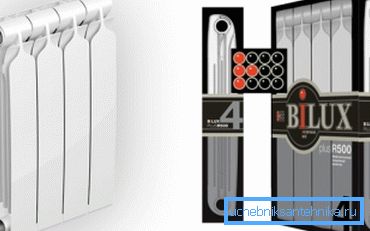
A number of negative reviews of aluminum radiators can be explained by the violation of the installation technology. The instruction requires that aluminum does not come into contact with metals such as steel, otherwise a galvanic couple is formed and an intensive process of metal corrosion is taking place. Some ignore this rule - hence the negative.
In conclusion
A detailed analysis of the characteristics of aluminum radiators and their comparison with analogues from other metals shows that the advantages are much greater, and the disadvantages are not critical. This explains the popularity of such radiators and suggests that in the future their market share will only grow.
The video in this article addresses the issue of installing an aluminum battery.
In the comments to this article, you can ask any questions about the choice of heating radiator.